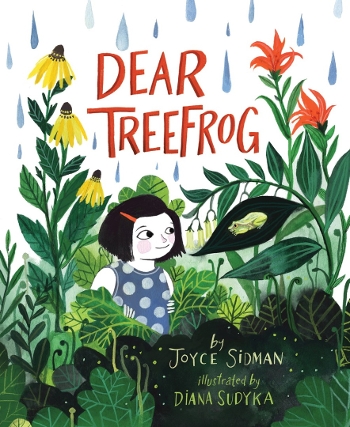Dear Treefrog gives us another wonderful collection of nature-themed poems by Joyce Sidman, but this time she has created a kind of novella in verse for the younger reader, with a story emerging across the spare, lyrical poems. Artist Diana Sudyka takes this framework and creates a whole world with her distinctive illustrations.
 Dear Treefrog gives us another wonderful collection of nature-themed poems by Joyce Sidman, but this time she has created a kind of novella in verse for the younger reader, with a story emerging across the spare, lyrical poems. With illustrations by Diana Sudyka that bridge the natural and the fantastical, the book follows a young girl as she moves to a new home. Her search for belonging parallels her quiet observation of the world outside her doorstep, and especially the treefrog that captures her imagination. I’d love to dig deep into Sidman’s writing and consider how cleverly and quietly she incorporates poetic elements, internal rhyme and subtle rhythm, metaphors and similes, vivid vocabulary, and descriptive details, along with the perfect prose paragraph on the opposing page that gives just enough information to support what we read and see. But my focus here is on how Sudyka takes this framework and creates a whole world with her illustrations.
Dear Treefrog gives us another wonderful collection of nature-themed poems by Joyce Sidman, but this time she has created a kind of novella in verse for the younger reader, with a story emerging across the spare, lyrical poems. With illustrations by Diana Sudyka that bridge the natural and the fantastical, the book follows a young girl as she moves to a new home. Her search for belonging parallels her quiet observation of the world outside her doorstep, and especially the treefrog that captures her imagination. I’d love to dig deep into Sidman’s writing and consider how cleverly and quietly she incorporates poetic elements, internal rhyme and subtle rhythm, metaphors and similes, vivid vocabulary, and descriptive details, along with the perfect prose paragraph on the opposing page that gives just enough information to support what we read and see. But my focus here is on how Sudyka takes this framework and creates a whole world with her illustrations.
Sudyka opens and closes the book with endpapers filled with watercolor paintings of a tadpole, treefrog, tree stump, rock, dragonfly, and raindrops — all in pale green. Then she presents the treefrog nestled on a large green leaf on the half title page, followed by a spread showing a sad girl watching a moving van being loaded with pieces of her home. The stage is set. “SUMMER” is introduced with ten spreads featuring each poem on the far left, the prose science fact on the bottom right, and a lush green landscape on nearly every page. So many shades of green are incorporated in all the different shapes of leaves and grasses in the yard our protagonist begins exploring. Large, colorful flowers in vivid yellows and pinks also appear with tiny labels, such as “bee balm” and “gray-headed coneflower,” alongside other creatures that co-inhabit this environment — the bumblebee, American robin, green bottle fly, and others, also subtly labeled. Fall, winter, and spring follow, taking us through a child’s school year, as well as the life cycle of a treefrog.
Sudyka has said her paintings are “inspired by a passion for nature and science, as well as a love for various folk art traditions,” and this blending of observational science with folk art motifs is distinctive. She also says that, as a child, “she was the one always looking under logs for snails and bugs,” and her love for nature is beautifully communicated in Dear Treefrog. She suggests that a back yard can be like a jungle, lush and green and full of life — if we only take the time to explore it. She plays with scale in a way that exaggerates some things, such as vivid flowers and dragonflies that are nearly half the page, all serving to emphasize their importance in the eyes of the young girl. Each scene moves with swirling energy in frequent twirls of green or with long green variegated stems reaching upward — sometimes suggesting expansive growth and sometimes dreamlike and imaginative, as when the poem “Do You Remember” traces the treefrog’s life from egg to adult.
The depiction of our young protagonist is also a captivating element in this story of poems. Against the lush background of many greens, she appears paper-white, outlined in a thin black line, and has a short black bob of hair, held by a red barrette. She always wears a simple triangular blue dress filled with large sky-blue circles, a very geometric contrast to the multi-layered wild, green landscape. Sudyka imbues her rosy cheeks and nose, almond eyes, and thin eyebrows and mouth with a great deal of emotion as the girl moves from initial frowns to wonder, irritation, fear, worry, and (in the end) a smile. To me, she evokes the energy of 1960s-style animation in her angular simplicity. A handful of other children pictured bring additional diversity with various shades of peach and brown skin and different hair textures. In the end, her new friend is a brown-skinned boy who shares her curiosity about nature and always appears wearing green (like the treefrog, her other new friend). It’s interesting to me that she appears without any pigment. What does that mean? She’s different and apart from the rest, but is she imagined? The omniscient narrator? Or just the artist’s way of making the curious child catch the reader’s eye amidst all the color of the natural world?
I do love how the poems are divided into the seasons of the year, moving along the girl’s gradual transition from old home to new home in the span of a year, as well as signifying the life cycle of the treefrog in broad strokes. I also love how Sidman has given each poem a title. These poem titles almost function as a story summary poem, beginning with “I See You” (the girl alone noticing the treefrog) and ending with “We See You” (the girl and her friend observing the treefrog together). The little girl has found a new friend in someone else who “watches” and listens and looks. This book is all about noticing — noticing nature, noticing the treefrog in each spread, noticing the tiny labels tucked away around plants and animals.
Imagine reading these poems without seeing any illustrations — the lyrical voice, the vivid descriptions. It could almost be Thoreau musing at Walden Pond. But with Diana Sudyka’s gouache paintings, our journey is that of a lonely girl curious about a very green world, noticing the little things, and making a friend along the way. With her blending of wild, expressive paintings and stylized folk art with repeated swirls and patterns, Sudyka helps us enter the story through the observant eyes of a child — and the large eyes of the treefrog, complete with transparent third eyelid!

ALREADY A SUBSCRIBER? LOG IN
We are currently offering this content for free. Sign up now to activate your personal profile, where you can save articles for future viewing.








Add Comment :-
Be the first reader to comment.
Comment Policy:
Comment should not be empty !!!